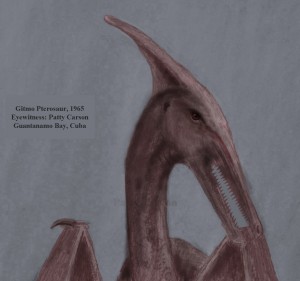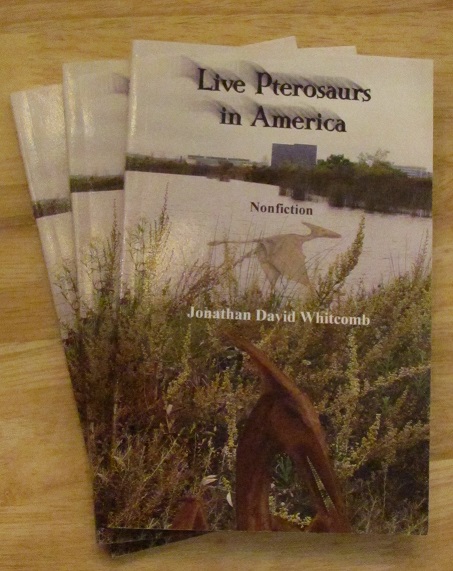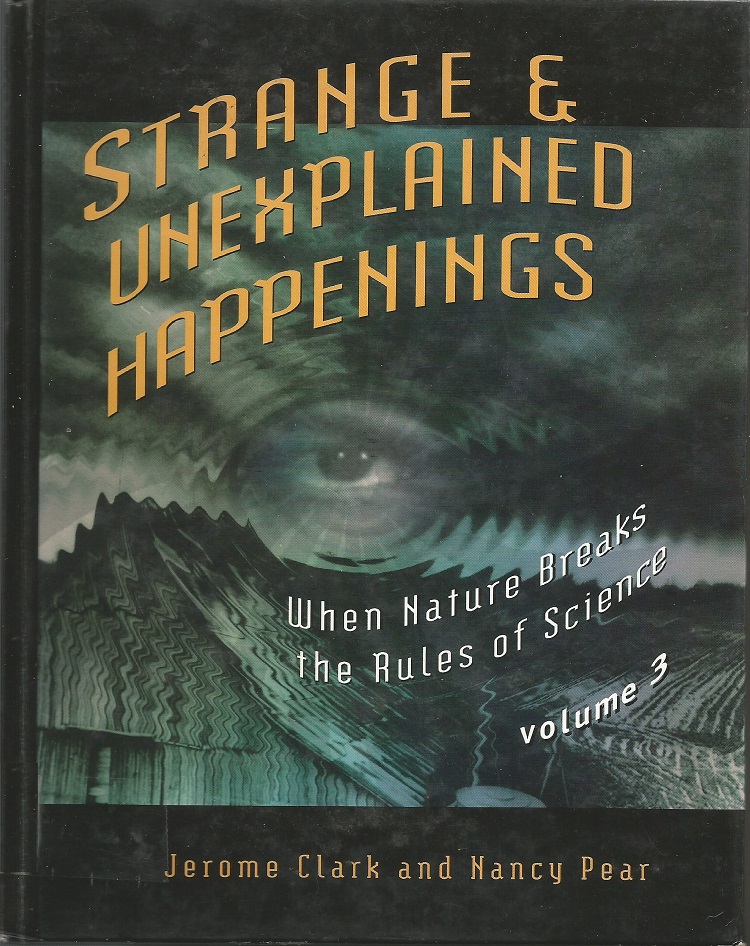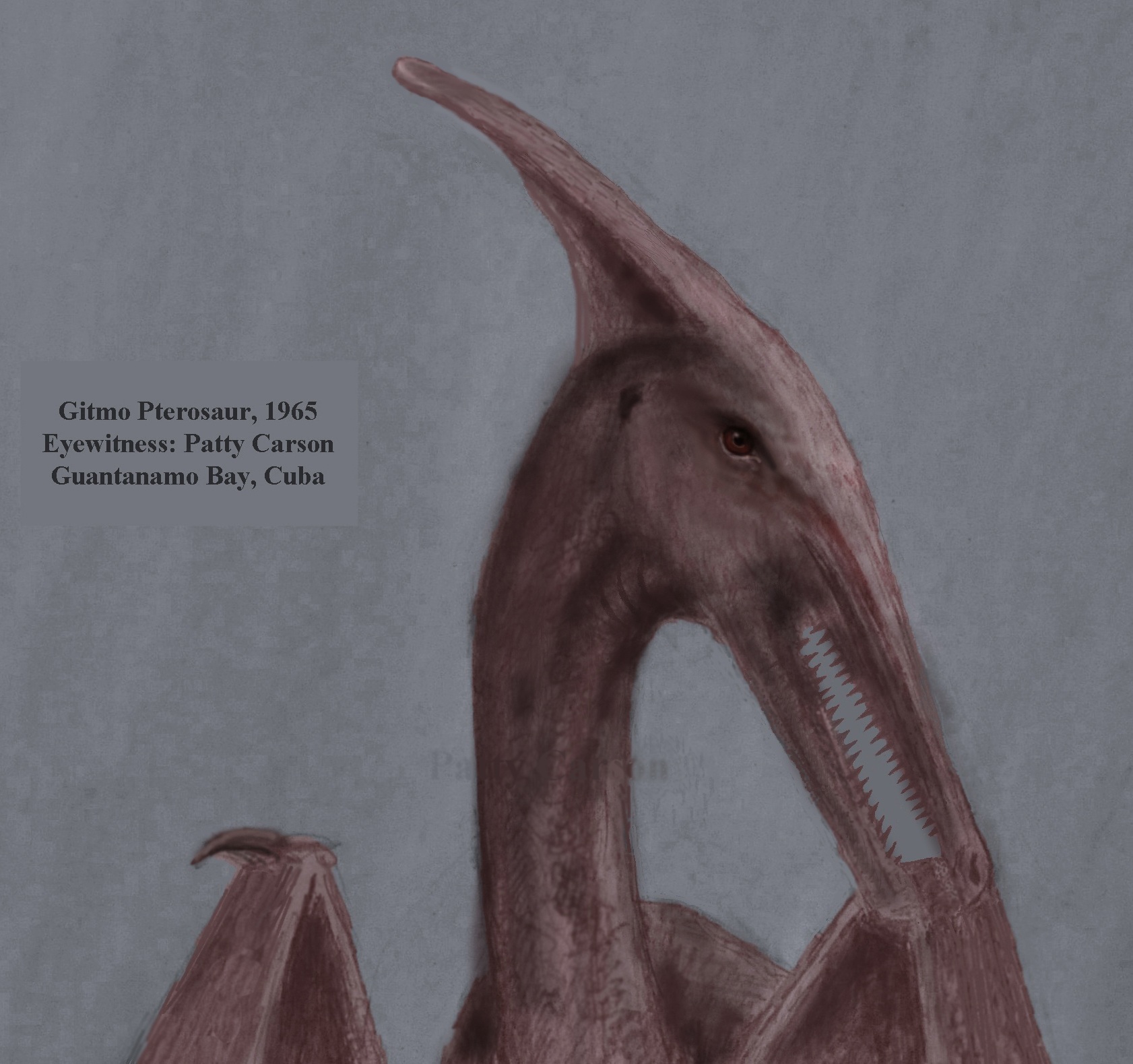Is the ropen a real animal, a modern living pterosaur? We now look at part of a Kindle book written by Darren Naish: Hunting Monsters – Cryptozoology and the Reality Behind the Myths. I’ve not read the whole book, so I’ll review only part of it, from the paragraph that begins with “moving away from tropical Africa” to slightly beyond the paragraph that ends with “how not to do an interview.” I personally deemed this book not worth purchasing, so I have to be content with reviewing only the portion that I can see on the Google-books page. Fortunately for me, much of the book’s content on living pterosaurs and the ropen seems to be available in Google-books.
I believe this portion of Hunting Monsters is in the fifth chapter, “Mokele-Mbembe, Ropen and Other ‘Prehistoric Survivors.’” If it turns out that significant content on living pterosaurs is in another part of the book then consider that my evaluation might need to be updated or modified. At any rate, this is not a standard book review, only an examination of a small part of this nonfiction by Darren Naish.
And yet this post you have just begun reading, long as it may be, is my response to only part of that small portion of the Kindle book by this paleontologist. Other points must be set aside for other blog posts.
Whitcomb vs Naish on Living Pterosaurs
We need to be clear about one point, something Dr. Naish and I (Jonathan Whitcomb) agree upon: that many varieties of pterosaurs known from fossils are extinct. The ones known to paleontologists outnumber the types known from sightings. We disagree completely, however, on the meaning of eyewitness sightings, for he believes that none of them were the result of a non-extinct pterosaur. I believe that some of them were precisely that: modern living pterosaurs.
Even the most optimistic cryptozoologist, after careful research, should come to realize that many species of pterosaur have probably become extinct. Exactly when they became extinct is open to questions that paleontologists like Naish appear unwilling to ask, yet the long tails with Rhamphorhynchoid-like flanges and the pointed head crests dominate too many eyewitness reports to ignore. Because of the great variety of forms known from fossils and the narrow range of descriptions in many reports of modern flying creatures, it seems obvious: Most species of pterosaurs are surely extinct.
We also agree that not all reports of a modern pterosaur come from encounters with living pterosaurs. This has probably often been overlooked, this point of agreement, perhaps overlooked even by Naish himself. I have found that at least a small portion of accounts appear to be one of the following:
- Misidentification of a non-pterosaur
- Hoax (including some YouTube videos)
- Mental health problem of the one reporting the encounter
Yet Naish and I appear to have taken different routes entirely. I dig into the details to get a better understanding of each report. I have spent well over 10,000 hours on the total sightings, including the many cases appearing to be unrelated to the three types shown above. I doubt that Dr. Naish has spent even 1% as much time on pterosaur sightings, for why would a typical paleontologist spend 100 hours objectively researching something that appears to undermine the foundation of his or her beliefs about when such flying creatures lived on this planet?
Yet we agree on some things. Dr. Naish and I agree to some extent on the quality of interviews of eyewitnesses. He mentioned my name but did not go into details about any particular interview that I conducted (he seemed to have been referring to my evaluation of an interview done by one of my associates when he mentioned “Jonathan Whitcomb”). If he had mentioned the details in my interviews with three young men (Gideon, Mesa, and Wesley), he would have been correct in saying that a number of factors were far from ideal.
But to sweep aside two whole expeditions on Umboi Island in 2004, because of perceived imperfections in interviewing technique in some of the interviews—that appears to be too extreme. I don’t expect Dr. Naish to invent a perfect time machine to take scientists millions of years into the past to prove his theories about ancient pterosaurs; my associates and I should not be expected to kidnap all the wildlife photographers in the world to force them to go with us to Umboi Island to get perfect video footage that proves the ropen is a modern pterosaur. So how often has an witness in a court been given perfectly conducted questioning? We need a practical approach, not an extreme dismissal of everything that might appear imperfect and contradicting our previous assumptions. If a particular interview had serious problems then those particular problems in that interview should be discussed. Dr. Naish appears to prefer to avoid bringing any such details to light.
Beware of jumping to the careless conclusion that a few pages in Hunting Monsters prove that all the expeditions and interviews and research of living-pterosaur investigators over the past 22 years is worthless. And those few pages in HM do not come close to refuting what is found in four scientific papers (three of them published in peer-reviewed journals), articles that are clearly in defense of modern pterosaurs. I see nothing in Naish’s book that even hints that any of those four scientific papers exist.
An Overview of Book Reviews of Hunting Monsters
Seventeen Amazon customer reviews of this new book, as of May 23, 2016, should give us enough to judge its popularity.
- Five Stars: 70%
- Four Stars: 12%
- Three Stars: 12%
- One Star: 6%
Many books on Amazon do worse than getting 70% top ratings from readers. I recommend going over these Amazon customer reviews of Hunting Monsters to learn the details. Before moving on, please be aware that I do not suggest that most potential readers will be disappointed after purchasing this book. Amazon suggests at least 70% will be satisfied with their purchase. But a small part of Hunting Monsters has major weaknesses; I cannot speak for the rest of the book.
.

Sketch by an eyewitness (sighting in Cuba in 1965)
.
Quetzalcoatlus and Sightings of Flying Creatures in Texas
Hunting Monsters, in this part of the book, has with a statement about sightings of apparent pterosaurs (ropen or otherwise) in the USA, in particular Texas. But do “most” sightings of apparent pterosaurs actually date to the “1970’s” as Dr. Naish declares? Not necessarily. Closer examination reveals that the actual sightings are spread out over decades.
But what’s so important to Naish about the 1970’s in Texas? It’s the discovery of Quetzalcoatlus fossils, beginning in 1971. The conjecture is hardly new. Other skeptics have also stumbled into this assumption: that news reports either caused or contributed to citizens in Texas believing they had witnessed living pterosaurs when they had actually not. The conjecture fails to include any details about exactly how it takes place, so skeptics can chose which explanation they like:
- Foolish Texans see ordinary birds and think they are seeing pterosaurs
- Hoaxers want attention, so they give false reports
Naish does not come close to proving either of the above, however, only suggesting that those are proper explanations for pterosaur sightings in Texas soon after the discovery of the Quetzalcoatlus. So where are the details that would give credence to the above two explanations for those sighting reports? Naish gives no detail at all, at least not in this part of his book: No particular sighting report is examined for judging the plausibility of those two explanations. Real science thrives on details and on numbers, but the number of analyzed reports he gives is zero.
Please be aware that I’m not out to make Dr. Naish look foolish. Yet a careless acceptance of his suggestion about reports of flying creatures in Texas—that can make quite a few citizens of Texas appear foolish. I will not use the word fool for anybody, for I have personally qualified for that adjective too many times in my own life. In this case, with eyewitnesses in the southern United States, I take the side of the majority: citizens of Texas versus Darren Naish. But still I prefer avoiding pushing individuals into one of two boxes with labels of fool and non-fool. Let’s just see which point of view is more realistic:
- At least some Texas eyewitnesses reported sightings reasonably accurately
- No Texan saw a living pterosaur, for Quetzalcoatlus news tainted their thinking
I submit that the first point of view is far better than the second.
At the end of 2012, I compiled a list of sightings: 128 reports, each of which I deemed more likely than not to have been from an encounter with a living pterosaur (worldwide sightings). I never said that it was close to a complete list, but I personally interviewed or questioned the eyewitnesses in close to 74% of these sightings.
This was more than just a simple listing, however, for the compilation had details like the following, with many of these involving a yes or no answer:
- Definitely no feathers
- Only probably no feathers
- Long tail
- Tail but not long
- Head crest
- Feet
- Teeth
- Wingspan
- Tail straight
- Tail flange
- Tail length
- Head-crest length
- Total length
- Clear sky
- Cloudy sky
- Clear view of creature
- Length of sighting in seconds
- Number of witnesses
- Height flying (when closest to the ground)
- Distance from eyewitness to flying creature
- Any soaring or gliding
- Any slow flapping
- Any fast flapping
- Near swamp or marsh
- Over water
- Near water
- Any change in direction (of flight)
- Year of sighting
- Year of interview or year when interviewing began
- Daylight
- Night
- Twilight
- Country (if not in USA)
- State (if in USA)
- Number of creatures
- Long neck
- Neck length
- [plus about a dozen other types of data or questions]
Of those 128 sighting reports, eight were in Texas, with these sighting years:
- 1976
- 1976
- 1976
- 1982
- 1983
- 1986
- 1995
- 1995
Please keep in mind that this is hardly a complete listing of sightings in Texas. These are the ones in Texas that attracted my attention and each appeared unlikely to have been from a hoax or misidentification or mental-health issue. Also be aware that I have been involved in sightings worldwide, while the cryptozoologist Ken Gerhard has investigated flying-creature sightings that were mostly in Texas. We’ll soon get to Gerhard’s writings.
Dr. Naish mentions “flaps,” which I interpret as temporary but concentrated interest in a subject of local or regional news. In Hunting Monsters, he says that they usually go away within a few weeks, and this is in the context of sightings of apparent pterosaurs in the state of Texas. But how do news reports of Quetzalcoatlus fossils relate to sighting reports of apparent pterosaurs in Texas? Let’s look at that.
The first fossil discovery of that species of pterosaur was in Texas in 1971. What an excitement that would have caused for paleontologists! Yet not every citizen of Texas is a paleontologist like Dr. Naish. So let’s examine all the pterosaur sighting reports that came out immediately after that exciting fossil discovery . . . well, actually not one sighting report seems to exist for within a few weeks of that discovery, at least not among the reports that I had compiled at the end of 2012.
Yet what if my reports from Texas are too limited? After all, they number only eight. Look at Big Bird – Modern Sightings of Flying Monsters by Ken Gerhard, which was published in 2007. Here are the sighting years for Texas:
- 1945 to the “present”
- Pre-1958
- 1970
- 1971 (Harlingen)
- 1975 (Robstown)
- 1975 (Rio Grande City)
- 1975 (San Benito)
- 1975 (near Los Fresnos)
- 1976 (five miles south of Harlingen)
- 1976 (two police officers see “white bird with 15′ wingspan”)
- 1976 (near Brownsville)
- 1976 (ranch north of Poteet)
- 1976 (Raymondville: wingspan=10-12 feet; leathery featherless skin)
- 1976 (Loredo)
- 1976 (northeast of Brownsville: resembled “Pteranodon“)
- 1976 (near Olmito)
- 1976 (San Benito)
- 1976 (Del Rio)
- Late 1970’s (Brownsville and Edinburg)
- 1976 (near San Antonio: three eyewitnesses)
- 1976 (Montalba)
- 1976 (Bethel)
- 1981-1983 (Houston)
- 1983 (east of Los Fresnos)
- 1983 (Hondo)
- 1990’s (Rangerville)
Of the above twenty-six Texas sighting reports listed in pages 77-79 of Gerhard’s book, which ones might have been caused by 1971 news reports of the Quetzalcoatlus? Well, maybe one, and that one is questionable. On page 77, it says, “unusual, brown bird.” That sounds like a puny “flap” to me. Why should anybody assume that news of a fossil discovery would cause that one eyewitness to think that an unusual-looking brown bird would be a non-extinct pterosaur? And even if it did, it would not explain the many other sighting reports.
I’m not saying that Dr. Naish is 100% wrong about news reports having a relationship to eyewitness accounts of apparent living pterosaurs, but I see a better suggestion about how it works.
What would citizens of Texas see in those news reports in 1971? Scientists found some fossil bones of a pterodactyl. How could anybody conclude from that news report that such flying creatures might still be alive? Suggesting such a conclusion appears to me to be insulting Texans. Perhaps one person might find a bone somewhere and wonder if it might be from that flying creature in the news, but even that possibility is questionable. To think that a newspaper or television news story would cause a considerable number of Texans to see ordinary birds and think they were “pterodactyls”—that strikes me as ridiculous.
I see a better explanation for any correlations that may become apparent between news reports of the Quetzalcoatlus fossil discovery and eyewitness accounts: News professionals are much more likely to publish reports of pterosaur sightings when such flying creatures are, or have recently been, in the news. Its the job of newspaper reporters to get relevant, timely news into their papers, so they are much more likely to publish stories about encounters with possible live pterosaurs when the that kind of flying creature has recently been in the news. In other words, the statistics of those sightings indicate they may happen in any year and in any decade, but they are published and brought into public attention much more when news professionals see timely news and then publish the encounters.
Indeed there may have been more news reports published and presented on television in the mid-1970’s in Texas, regarding the Quetzalcoatlus discoveries, for more fossils were found in 1972 and 1974. As I understand, Douglas A. Lawson published something about these discoveries in the journal Science in 1975. This is perfectly in harmony with the idea that an increased number of living-pterosaur sighting articles in Texas came from an increased awareness by news professionals, not from any increase in the number encounters themselves.
Something else may have completely passed by the attention of Darren Naish. Valid eyewitness encounters with actual living pterosaurs may not have increased after the Quetzalcoatlus fossil discoveries but the eyewitnesses themselves may have been more likely to recognize the significance of what they had seen after they read about those fossils in the newspapers. In other words, actual sightings of non-extinct pterosaurs could have been reported much more frequently when the fossil discoveries were in the news, but the numbers of actual encounters did not change.
Before leaving this examination of sighting reports in Texas, let’s consider a brief Google search that I conducted on May 23, 2016. The following phrase was used: pterosaur sightings in Texas. Of the ten results on the first page, one was for images, but the other nine revealed some interesting facts on the years of reported sightings of living pterosaurs:
Six were in 1976 and eight were in other years, as follows:
- 1982
- 1982
- 1986
- 2007
- 2008
- 2008
- 2011
- 2013
In other words, most of the sighting years do not appear to correlate closely with discoveries of Quetzalcoatlus fossils, and even if they did, it could easily be explained by an increased openness of news professionals to publish those sightings when the fossil discoveries of such flying creatures were already being published in newspapers and presented in television news broadcasts.
It may appear, on the surface, that the year 1976 may be significant, with all those reported encounters with apparent pterosaurs in Texas, yet it’s not likely anything close to what Dr. Naish declared in his book: He said that the “flaps” die down after a few weeks. In reality, reports of living pterosaurs in Texas not only do not die down within a few weeks, but they continue for years. In addition, they are seen to have arisen even before the first discovery of a Quetzalcoatlus fossil in 1971, according to Ken Gerhard’s research.
In Defense of the Ropen
One more detail on which Dr. Naish and I agree: The ropen is not a Quetzalcoatlus. In fact, the descriptions of the modern long-tailed flying creature correlate with the features of a Rhamphorhynchoid (“basal”) pterosaur, not a Pterodactyloid short-tailed pterosaur.
From the end-of-2012 compilations of data from the more-credible sighting reports, we learn that the ratio of long-tail to no-long-tail is close to twenty-to-one (41% to 2%). That’s a clearly significant statistical fact, for the 41% is for the entire 128 sightings. So why do so many eyewitnesses, worldwide, report long-tailed pterosaurs when the media and fiction films and television science fiction shows have so many short-tailed pterosaurs? The long-tailed ropen is the dominant type of pterosaur now living on this planet.
###
.
The Long Tail of the Ropen
The Fiery Flying Serpent of the Bible may have been a long-tailed Rhamphorhynchoid, related to the modern-day ropen.
Pterosaur Sightings Data for the USA
This includes the sightings in Texas, but also it has many other states, including Alabama, Arizona, Arkansas, California, Florida, Georgia, Idaho, Illinois, Indiana, Kansas, Kentucky, Louisiana, etc.
Fossils are Evidence of Life, not Extinction
The Mesozoic Objection for live pterosaurs and Darren Naish (a paleontologist)
Ropen Sighting
Peter Beach and Milt Marcy, both of the Portland area of Oregon, led an expedition in Papua New Guinea, in March and April of 2015, searching for a living pterosaur . . .
Ropen in Texas and in New Mexico
. . . modern pterosaurs in the United States, in spite of extinction dogma. Marvel at eyewitness accounts in many of the states: California, Texas, New Mexico, Florida, and in other states.
Pterosaur Sighting in South Carolina
Susan Wooten, of Greenville, South Carolina, was driving from home to Florence (about 1989) when she saw a giant creature glide over the highway in front of the car.
Marfa Lights in Texas – a Ropen?
A few American cryptozoologists, including the Californians Jonathan Whitcomb and Garth Guessman, and the Texan Paul Nation, have searched for nocturnal bioluminescent flying creatures described like Rhamphorhynchoid pterosaurs. . . .
.









